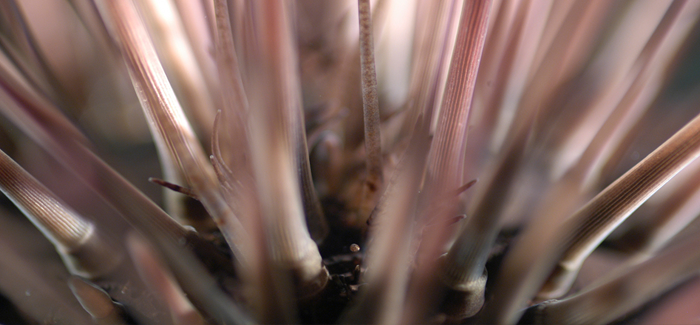
The treelike spines of Arbacia punctulata, the purple-spined sea urchin. (Photography by Michael LaBarbera)
Retiring professor Michael LaBarbera’s Invertebrate Biology class concludes with a view of an “alien landscape.”
 A year ago, I spent most of a quarter tagging along with professor Michael LaBarbera’s (right) Invertebrate Biology class. I followed his undergrads from the lecture room to the lab week after week, listening as they discussed taxonomies that cascaded like crazy tournament brackets, and watching as they dissected squids and horseshoe crabs and a little worm called a sipunculid. I hung out with the live animals in the lab’s aquariums—jellyfish, starfish, clams, crabs, sea squirts—which in LaBarbera’s lectures seem less like specimens than like characters in a story. Technically, I was working—I was reporting a feature for the Magazine—but mostly I was having fun.
A year ago, I spent most of a quarter tagging along with professor Michael LaBarbera’s (right) Invertebrate Biology class. I followed his undergrads from the lecture room to the lab week after week, listening as they discussed taxonomies that cascaded like crazy tournament brackets, and watching as they dissected squids and horseshoe crabs and a little worm called a sipunculid. I hung out with the live animals in the lab’s aquariums—jellyfish, starfish, clams, crabs, sea squirts—which in LaBarbera’s lectures seem less like specimens than like characters in a story. Technically, I was working—I was reporting a feature for the Magazine—but mostly I was having fun.
I learned all about the tragic life cycle of the octopus and the deadly toothed tongue of the banded tulip snail. I learned that molting is one of the most miserable and perilous experiences any animal can go through. (Halfway through the quarter, the blue crab living in one of the aquariums got stuck mid-molt and died overnight, his discarded shell dangling above him, still partially attached. The class found him the next day. “Poor guy,” someone said.) I learned that shrimp have a surprising amount of personality and that worms are beautiful, some of them hauntingly so.
One thing I missed, though, was the sea urchins. Echinoderms (a group that also includes starfish and sand dollars) came up late in the quarter, and magazine deadlines got in the way. LaBarbera emailed me the day I skipped his lab: “You haven’t lived until you’ve looked at a sea urchin in a dissecting microscope,” he said. “The most alien landscape you can imagine.”
So this year I made sure to be there. It was my last chance; after 36 years at UChicago, LaBarbera retired in December, and the College’s Invertebrate Biology course is retiring with him.
[[{"type":"media","view_mode":"media_original","fid":"2220","attributes":{"alt":"","class":"media-image","height":"362","typeof":"foaf:Image","width":"460"}}]]
The alien landscape of the purple-spined sea urchin.
Anyway, he was right: an entirely alien landscape. As I looked through the microscope at a live, pulsing Arbacia punctulata, the purple-spined sea urchin, LaBarbara narrated what I was seeing: “So, the tree-looking things are the spines,” he said. “The little snakey things are the tube feet”—used for locomotion and respiration, among other functions. “The thing in the middle of the trap doors—that’s the anus. There’s just one of those. But they have these four cover plates over it, to make sure nobody does anything they’re not supposed to.” Waving back and forth amid this tableau were little stalks with jaws on the end, the pedicellariae. “What they do is, if some little animal tries to land on this guy, they grab it and crush it.”
On the opposite side of the urchin—the “business end,” LaBarbera called it as he rolled the animal over—sat the mouth, a swiveling maw in constant motion (you can see it in the video above), with five radiating jaws that come together at a point (“Aristotle’s lantern,” that structure is called) and teeth that move in and out. Surrounding the mouth, LaBarbera explained, are “tiger-striped things that on the end look like a kidney bean.” Those are modified chemosensory tube feet: “In other words, they’re tasters.” Out in the wild, the sea urchin stands with its mouth facing downward, allowing its tube feet to sample what’s on the sea floor below. “And if it tastes good, it bites a piece off.”
[[{"type":"media","view_mode":"media_original","fid":"2221","attributes":{"alt":"","class":"media-image","height":"444","typeof":"foaf:Image","width":"460"}}]]
The sea urchin’s five-jawed mouth, a complex apparatus with self-sharpening teeth and a swivel that can move in all directions.
The lab took place Friday, December 5, a couple days before finals. The sea urchin was a fitting spectacle for LaBarbera’s very last Invertebrates lab: weird and thrilling and a little surprising, with just a hint of wild danger. The animal drew oohs and ahs from students, who, on their way out the door, turned in their lab books with a quarter’s worth of diagrams and notes to be graded. The last student to leave shuffled nervously for a moment in front of LaBarbera, then said, “I want to thank you for this class.” It had rekindled a grade-school fascination with marine invertebrates, the student said, and now he was interested in studying the animals further, maybe going to grad school. “You have shown me that these sciences are very dynamic,” he said. “It’s really been a shift over this quarter.”
LaBarbera, carrying a little hunk of shrimp on his way to feed the creatures in the big tank at the front of the room, stopped and smiled. “Wonderful,” he said. “Let’s keep in touch.”
